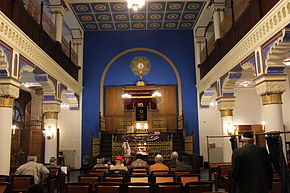Brody Synagogue (Leipzig)
The Brodyer Synagoge is a synagogue at Keilstrasse 4-6 in Leipzig . The synagogue was named after the city of Brody in what is now Ukraine .
description
The Brodyer Synagoge is an Orthodox synagogue in Saxony . The Jewish religious building is part of the closed development in the area north of the Leipzig inner city ring. The facade of the sacred building facing Keilstraße shows wheel-shaped windows with colored art glass on the ground floor.
Previous buildings in Leipzig
The sacred building at Keilstraße 4 goes back to the Leipzig Brody Schul (Yiddish: שול בראָד / ברוד) at Brühl 71 (house "Blauer Harnisch"), founded in 1763/64 , which was built by Eastern Jewish fur merchants from Brody after their Eastern Jewish synagogue from their Galician place of origin was named. The East Jewish tobacco merchant Harmelin, who came from the Galician shtetl Brody, owned a warehouse in the “Blauer Harnisch” in Leipzig. The Harmelin family from Brody, Ukraine, ran a bristle and fur commission company in Leipzig.
Leipzig synagogue at Keilstrasse 4
The prayer room at Keilstraße 4 in Leipzig was located in a double house that was built in 1898 for the Leipzig master carpenter Louis Börner based on designs by Georg Wünschmann .
On December 16, 1901, the building application for the establishment of a prayer room at Keilstraße 4 was submitted. Oscar Schade provided the designs . The sacred space was intended to serve immigrant, Orthodox Eastern Jews who could not hold a service in the Leipzig synagogue , since only Reformed services were allowed there. In 1903, the Talmud Torah Association , chaired by the Jewish businessman and banker Hans Kroch, acquired the building from Friedrich Gutfreund . During the renovation in 1904, the apartments on the ground floor and first floor were combined into a single room. After the renovation work, the synagogue was named after the place Brody.
On June 30, 1937, the premises were transferred to a property management trust company as part of the Aryanization . Alfred Eibenschütz was cantor (Chasan), Hillel Schneider worked as chief cantor and from 1938 Samuel Lampel. Ephraim Carlebach was a religion teacher and later rabbi of the synagogue. In the pogrom night of 9/10 November 1938 , the interior was demolished and the sacred space desecrated because it was in a residential building, but it was not set on fire. After that the building was used as a soap factory. The building was inaugurated again on October 28, 1945 and has been Leipzig's only synagogue ever since. After restoration, the building was re-consecrated as a synagogue on May 22, 1993 and has been used by the Leipzig Jewish Community ever since .
Architecture and equipment
The synagogue has a capacity of 510 seats. The building is a gallery hall. The galleries rest on columns that are designed in an oriental historical style:
“The three-aisled room with a three-sided female gallery is richly furnished in the neo-Moorish style: arabesque shapes and multicolored geometric patterns give an impression of how the once numerous 'Moorish' synagogues of the 19th and early 20th centuries may have worked. The Leipzig synagogue is the only one of this style in Germany that can still be used by a Jewish community. "
The original equipment was in the Reichspogromnacht from 9./10. Destroyed November 1938. In the Torah shrine there are currently four Torah scrolls from the 18th and 19th centuries. with rich silver work. The rods of the scrolls are adorned with crowns (keter) with bells hanging from them. In front of the rolls there is a massive shoulder shield (cup), some with attached dedication medallions.
literature
- Wolfgang Hocquél : Leipzig: Builders and Buildings: from the Romanesque to the present . Tourist Verlag, Berlin / Leipzig 1990, ISBN 3-350-00333-8 , Synagoge, Keilstraße 4., p. 149 .
- Heinrich Magirius, Johannes Gerdes (Saxony. State Office for the Preservation of Monuments): City of Leipzig - the sacred buildings . With an overview of the urban development from the beginnings to 1989. Volume 1 . German Kunstverlag, Munich 1995, ISBN 3-422-00568-4 , Brodyer Synagoge, p. 801-803 .
- Adolf Diamant: Chronicle of the Jews in Leipzig . Ascension, annihilation, and a new beginning. Verl. Heimatland Sachsen, Chemnitz / Leipzig 1993, ISBN 3-910186-08-4 , p. 230, 268 .
- Steffen Held: The synagogue of the Israelite religious community in Leipzig . Leipziger Geschichtsverein eV, Leipzig 1999.
- Sylvia Kabus: We were the last ...: Conversations with displaced Jews from Leipzig . Sax-Verlag, Leipzig 2003, ISBN 978-3-934544-41-3 , p. 119 .
- Barbara Kowalzik: Jewish working life in the inner northern suburb of Leipzig 1900–1933 . Ed .: Petra Listewnik. Leipziger Universitätsverlag, Leipzig 1999, ISBN 978-3-933240-84-2 , p. 22, 29 ff .
- Bernd-Lutz Lange: Jewish traces in Leipzig . Forum Verlag Leipzig, Leipzig 1993, ISBN 978-3-86151-049-9 , p. 43-47 .
- Horst Riedel: Stadtlexikon Leipzig from A to Z . Pro Leipzig, Leipzig 2005, ISBN 978-3-936508-82-6 , pp. 584 f .
Web links
- German-Russian Center Saxony eV Brody Synagogue - Talmud-Torah Synagogue. (No longer available online.) In: juden-in-Sachsen.de. Archived from the original on July 4, 2015 ; accessed on February 28, 2018 .
- Jewish mess broker Max Hermelin from Brody (Ukraine) and his warehouse in the Leipzig house "Zum Blauen Harnisch". (No longer available online.) In: juden-in-Sachsen.de. Archived from the original on July 4, 2015 ; accessed on February 28, 2018 .
Individual evidence
- ^ Heinrich Magirius, Johannes Gerdes (Saxony. State Office for Monument Preservation): City of Leipzig - the sacred buildings . With an overview of the urban development from the beginnings to 1989. Volume 1 . German Kunstverlag, Munich 1995, ISBN 3-422-00568-4 , Brodyer Synagoge, p. 801-802 .
- ^ Description of the Brody synagogue. (No longer available online.) In: www.zentralratdjuden.de. Archived from the original on March 4, 2016 ; accessed on March 6, 2018 .
Coordinates: 51 ° 20 ′ 45 " N , 12 ° 22 ′ 26.6" E

